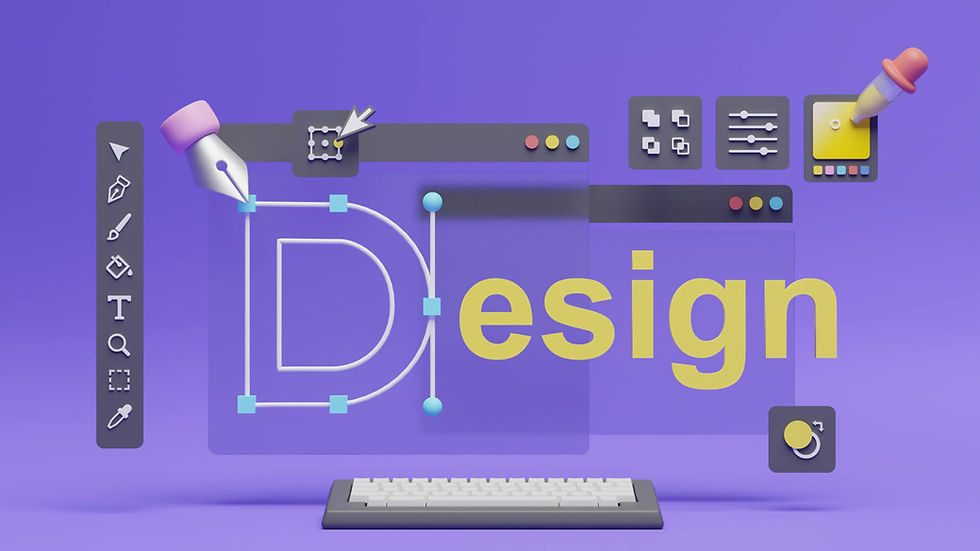The Changing Landscape of Design Tools
- Anthony Garcia

- Sep 21, 2024
- 4 min read
Updated: Feb 15

Design tools have undergone a dramatic evolution over the past two decades, shifting with both market and user demands. Gone are the days when design tools were simply applications downloaded onto your computer. Many have now transitioned into web-based platforms, meaning you can access them directly from your browser. This shift brings with it a challenge for designers: keeping up with the rapid development of tools and deciding which ones are worth learning.
As a designer, I’ve felt this pressure, especially in the last five years, with new tools emerging quickly. It can feel overwhelming to stay updated, and at times, it seemed like I needed to master every new tool to stay competitive. However, I’ve learned to prioritize which tools to learn based on my needs, career direction, and workflow. Over time, I've also discovered that many tools are similar in functionality, and the key is choosing the right ones for your goals.
The Journey of Design Tools Over the Years
Back in 2010, when I started my design career, Adobe Creative Suite reigned supreme. I had to install it from a disc—hard to imagine now in 2024 when my MacBook doesn’t even have a disc drive! Fast forward to today, and everything is cloud-based. In those early days, using Photoshop, InDesign, and Illustrator felt like using the industry standard, and it was. It wasn’t until later that tools like Figma, Sketch, and Webflow entered the picture.
In 2015, as a young graphic designer, I heavily relied on Adobe software. However, as my career progressed, my toolset expanded. By 2018, video editing tools like Premiere Pro and After Effects became part of my daily routine. It wasn’t until 2020 that I started moving towards web-based tools like Figma, which quickly gained popularity for its collaborative features and live feedback capabilities. The global pandemic also accelerated this shift, making real-time collaboration more critical than ever.
Now in 2024, my priorities have shifted again. While I still use design tools like Figma, my focus has broadened. I’m increasingly drawn towards tools that help businesses with structural and operational challenges. Tools like Smartsheet, ClickUp, Notion, and FigJam which focus on project management, process mapping, and documentation, have become invaluable in my current work. These platforms enable seamless collaboration across teams, regardless of location, which is crucial in today’s globalized working environment.
Choosing the Right Design Tools
When deciding which tools to learn, it’s essential to consider where you are headed in your design journey. As my role evolved, so did my toolkit. While I began with Photoshop and After Effects, my current needs focus more on tools like FigJam and Smartsheet.
However, one important lesson I’ve learned is that many tools serve the same function. For example, while Figma and Webflow are different tools, their capabilities overlap in web design, making both viable options depending on your project. Similarly, project management tools like Smartsheet, ClickUp, and Wrike allow you to manage workflows, even though they may differ in their interfaces.
Design tools like Wix, WordPress, and SquareSpace allow for quick website creation, and again, while the user interfaces may vary, the results are similar. Even Canva, which revolutionized easy design for non-designers, has its counterpart in Adobe Express. This convergence of functionality makes it essential to focus on the tools that best serve your immediate needs rather than getting bogged down by the sheer number of options.
The Importance of Flexibility
While it can be tempting to try every shiny new tool, it’s important to recognize that many of these tools are becoming increasingly similar. The key is to find what works best for you and your projects. At the same time, it’s worth keeping an eye on emerging tools, as the industry continues to consolidate through mergers and acquisitions, which may lead to fewer, more comprehensive platforms.
Over time, I've learned to quickly adapt to new tools because of the similarities between them. This adaptability has allowed me to focus more on the work and less on the tools, which is a crucial skill in an ever-evolving industry. The shift towards online platforms has also enabled easier collaboration and real-time feedback, which is a major benefit in today’s remote working world.
Conclusion
Design tools will continue to evolve, and while it can be daunting, I find it exciting because it aligns with one of my core values: being a lifelong learner. Rather than getting caught up in the hype of every new tool, it’s essential to recognize that many of them are not all that different. As tools become more standardized, we may see fewer new tools and more consolidation in the market.
Ultimately, the tool is just that—a tool. It’s there to help you achieve your goals, but it shouldn’t define your work. Focus on what excites you, what aligns with your calling, and what helps you deliver the best results. The design industry will continue to change, but the key is to remain flexible and open to growth, both personally and professionally
Comments